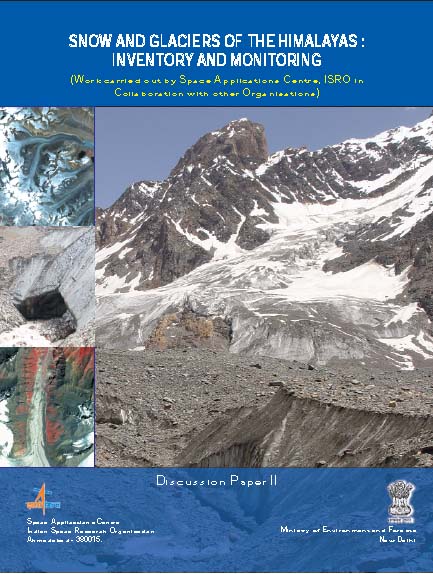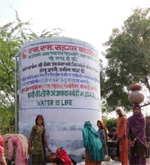Rainfall and other forms of Precipitation
Changing with the seasons: How Himalayan communities cope with climate change - A report by Peoples’ Science Institute
Posted on 14 Jun, 2011 10:51 PMMountain areas and communities are susceptible to climate change. This work also yielded evidence of the coping strategies developed by the communities to deal with an unprecedented and only partially understood threat. This paper describes these strategies and attempts to assess the vulnerability of the communities in each valley.
Snow and glaciers of the Himalayas – A study by Indian Space Research Organisation
Posted on 14 Jun, 2011 07:58 PM The study on “Snow and Glacier Studies” was taken up by the Space Applications Centre, Indian Space Research Organisation (ISRO) and executed in collaboration with fourteen research organizations and academic institutions of the country, at the behest of the Ministry of Environment and Forests.
The study on “Snow and Glacier Studies” was taken up by the Space Applications Centre, Indian Space Research Organisation (ISRO) and executed in collaboration with fourteen research organizations and academic institutions of the country, at the behest of the Ministry of Environment and Forests.
Himalayan mountains contain important natural resources of frozen fresh water in the form of snow and glaciers. These glaciers are unique as they are located in tropics, high altitude regions, predominantly valley type and many are covered with debris.
The great northern plains of India sustain on the perennial melt of snow and glaciers meeting the water requirements of agriculture, industries, domestic sector even in the months of summer when large tracts of the country go dry. Therefore, it is important to monitor and assess the state of snow and glaciers and to know the sustainability of glaciers in view of changing global scenarios of climate and water security of the nation. Any information pertaining to Himalayan glaciers is normally difficult to be obtained by conventional means due to its harsh weather and rugged terrains.
Patkhori's water solutions - A case study from the work of SM Sehgal Foundation in Mewat, Haryana
Posted on 14 Jun, 2011 05:27 PM Community water tank
Community water tank
Long range forecast for 2011 South-west Monsoon season rainfall - Press release by IMD
Posted on 14 Jun, 2011 03:39 PMThe Long Period Average (LPA) of the south-west monsoon season rainfall over the country as a whole for the period 1951-2000 is 89cm. The first long range forecast for the south-west monsoon season (June-September) rainfall is issued in April and the forecast update is issued in June.
Monsoon 2011 onset over Kerala - A meteorological analysis by IMD
Posted on 08 Jun, 2011 05:39 PMIndia Meteorological Department has objective criteria for declaring the onset of monsoon over Kerala.
Changes in extreme rainfall events and flood risk in India during the last century- A report by the India Meteorological Department
Posted on 21 May, 2011 05:53 PM The occurrences of some exceptionally heavy rainfall during the recent years causing flash floods in many areas necessitated the study of long term changes in extreme rainfall over India.
The occurrences of some exceptionally heavy rainfall during the recent years causing flash floods in many areas necessitated the study of long term changes in extreme rainfall over India.
The study includes the analysis of the frequency of rainy days, number of rainy days and heavy rainfall days as well as one-day extreme rainfall and return period analysis in order to observe the impact of climate change on extreme weather events and flood risk. It has been found that frequency of heavy rainfall events are decreasing in major parts of the central and north India while increasing in peninsular India, east and north east India.
The report provides interesting findings that are useful for hydrological planning and disaster managements such as –
Monsoon blues - Don't take the Met Department's "almost normal" monsoon prediction for 2011 for granted - Article by Devinder Sharma
Posted on 21 May, 2011 09:51 AMYou must have heard of the meteorological department’s monsoon forecast. It promises to be a near normal monsoon season from June-September with rains expected to be 98 per cent of the long period average with a 5 per cent variation. Sounds good.
Varunyantra to tap skywater: A Bhagirath effort
Posted on 17 May, 2011 03:51 PM
Although there is enough water in the world, it is rarely in the right place at the right time in the right quantity and quality.
Cloud seeding for India - An effective weapon to fight drought , saysProf. Shivaji Rao
Posted on 17 May, 2011 03:51 PMThe more the water wealth of a nation the higher will be the opportunities for achieving high rates of progress in the fields of agriculture production and industrial growth that help in promoting economic wealth, employment opportunities and higher standards of living. Hence the advanced countries are constantly upgrading their water resources by harnessing not only all the ground and surface waters but also by tapping a renewable, virtually unlimited and unexploited sky water resource in the atmosphere in the form of innumerable clouds. Enlightened scientists, bureaucrats, industrialists and statesmen in about 50 countries are frequently using cloud seeding operations for over 40 years for various purposes like





